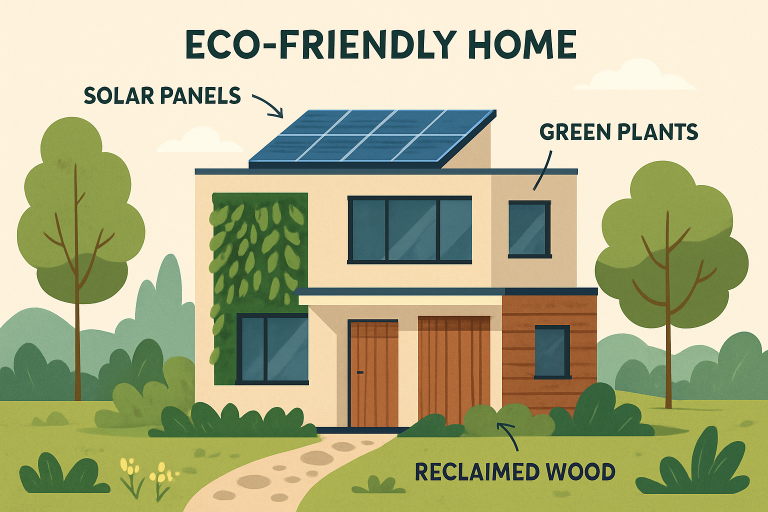Modern life demands innovation that respects both the environment and the well-being of its inhabitants. As sustainability continues to shape architectural trends, eco-conscious homebuyers and designers are increasingly seeking solutions that minimize environmental impact while maximizing comfort, functionality, and aesthetics. One key strategy is to adopt forward-thinking design philosophies and materials—ranging from reclaimed resources to energy-efficient systems—that align with today’s pressing environmental priorities. If you’re searching for sustainable ideas or home plans Elk River, MN, this guide offers practical insight into how green principles are revolutionizing modern living spaces. The movement towards sustainable architecture is more than an aesthetic pursuit; it’s a response to pressing global concerns, such as climate change and resource scarcity. Today’s green buildings aren’t just beneficial for the planet—they create healthier and more cost-effective homes for families and communities. By learning from pioneering projects worldwide and incorporating nature-inspired solutions, homeowners can contribute to a cleaner future without compromising style or comfort.
Eco-Friendly Materials
Eco-friendly materials form the core of truly sustainable architecture. Using reclaimed wood salvages existing resources and decreases the demand for new timber, which helps prevent deforestation and promotes forest conservation. Reclaimed wood can add a unique character and warmth to interiors, blending sustainability with beauty. Besides wood, architects are also using recycled metals—such as steel from old warehouses or copper from outdated wiring—to build strong, durable frameworks while cutting down the need for energy-intensive raw metal extraction. Bio-based composites, like those made from bamboo or mycelium, are becoming more popular because they renew quickly and have a low environmental impact. These materials naturally break down at the end of their lifecycle, supporting circular building practices. Using these materials not only lessens a building’s environmental footprint but can also improve indoor air quality by avoiding toxic chemicals commonly found in traditional construction products.
Energy-Efficient Designs
Architectural innovation goes beyond materials by integrating energy efficiency into every aspect of home design. Key features include passive solar orientation, which involves strategically placing windows and living spaces to capture winter sun while shading out summer heat. High-performance insulation, coupled with airtight building envelopes, dramatically reduces heating and cooling demands. Triple-glazed windows and reflective roofing further enhance efficiency. A notable example is the Solar Umbrella House in Los Angeles, which generates nearly all its required electricity via a sophisticated array of solar panels, epitomizing how renewable energy integration can power everyday living with minimal environmental impact. These advances don’t just lower carbon emissions—they also result in significant utility savings for homeowners.
Adaptive Reuse
Adaptive reuse provides a creative approach to repurposing outdated structures, thereby reducing the environmental impacts associated with demolition and new construction. Engineers and designers approach abandoned factories, warehouses, or even garages as blank canvases for sustainable transformation. In London’s Bethnal Green neighborhood, a derelict garage was reborn into a charming, sustainable residence using a blend of recycled bricks, timber, and sustainable insulation. The project doesn’t just minimize waste—it offers a blueprint for urban renewal, retaining cultural heritage while adapting to present-day needs. This method embodies sustainability by striking a balance between resource conservation and a commitment to contemporary comfort and functionality.
Biophilic Design
Biophilic design draws inspiration from the natural world, promoting physical and emotional well-being through features such as green walls, natural light, and living roofs. Research consistently demonstrates that access to daylight and greenery can lower stress, boost productivity, and enhance overall health—benefits that commercial offices and residential developers alike are increasingly adopting. The Kendeda Building for Innovative Sustainable Design at Georgia Tech exemplifies biophilic architecture, featuring solar-shaded windows, rainwater harvesting systems, and lush rooftop gardens that promote biodiversity and provide restorative outdoor spaces for users. Biophilic principles are becoming increasingly vital in urban environments that seek to balance dense development with accessible natural spaces.

Case Studies
- New Gourna Village, Egypt: Designed by visionary architect Hassan Fathy, this sustainable community harnessed traditional mudbrick and natural ventilation—proving that low-tech solutions can be exceptionally resilient and eco-friendly. Fathy’s approach relied on local labor and indigenous materials, drastically reducing project costs and environmental impacts.
- Nokken Hotel Cabins: These minimalist, modular retreats are constructed from sustainably sourced timber, featuring off-grid amenities such as composting toilets and solar energy. The small footprint and eco-friendly design enable travelers to experience nature intimately without leaving a negative trace.
Conclusion
Sustainable architecture represents more than a passing fad; it charts the road toward responsible, adaptable, and inspiring modern living. As architects and homeowners integrate eco-friendly materials, energy-efficient designs, adaptive reuse solutions, and biophilic strategies into their projects, communities benefit from lower environmental impact, improved health, and lasting aesthetic value. These forward-looking trends serve not only as a model for decarbonizing the built environment but also as an investment in the prosperity and well-being of future generations.
Read More : ecryptobit .com Exploring the Features and Benefits

